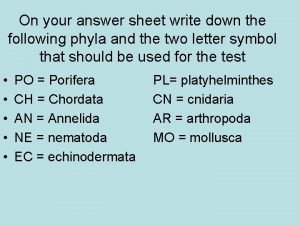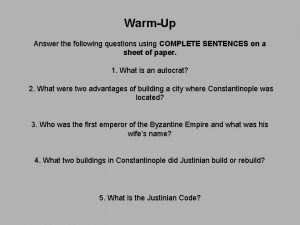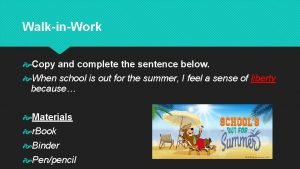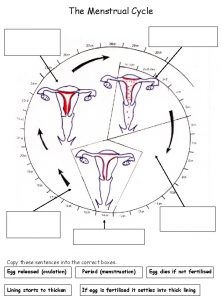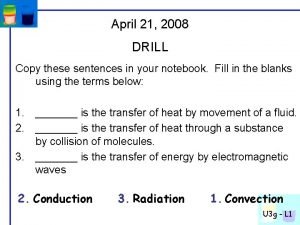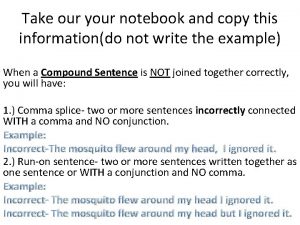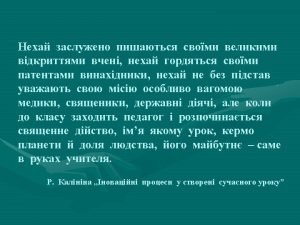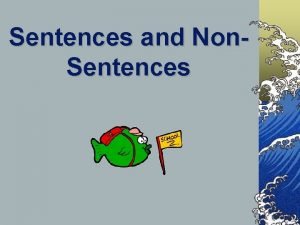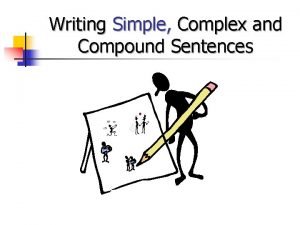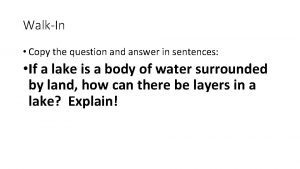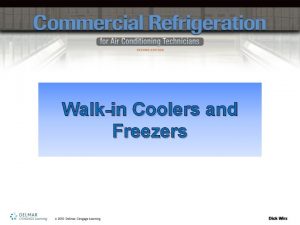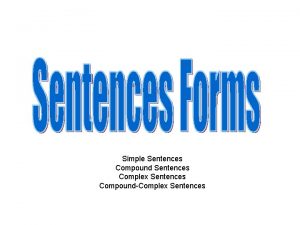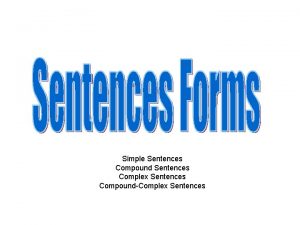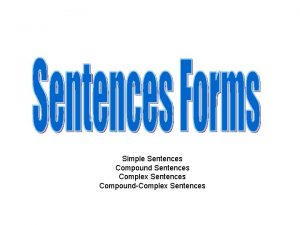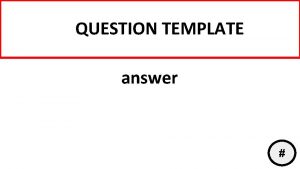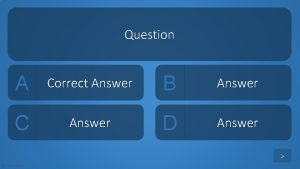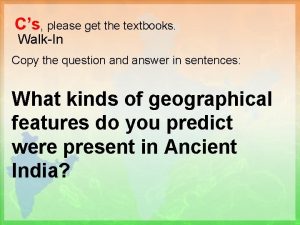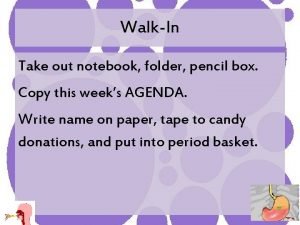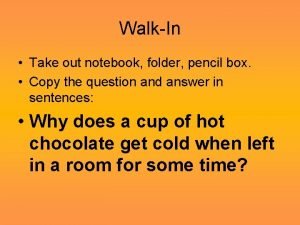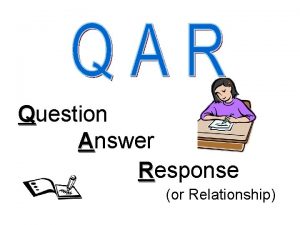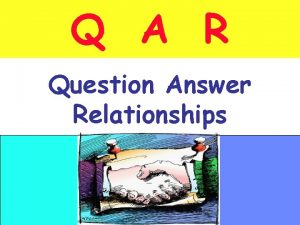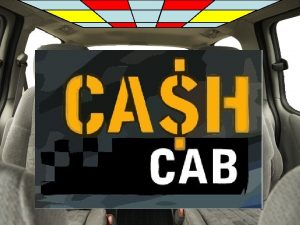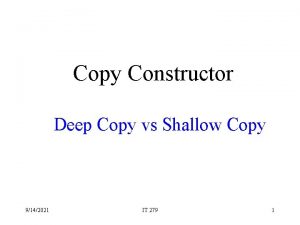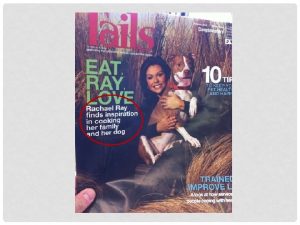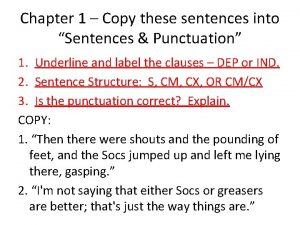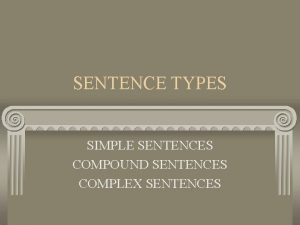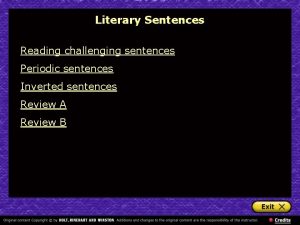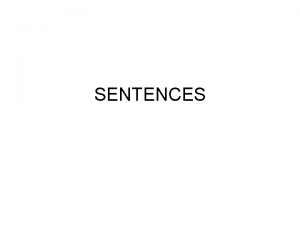WalkIn Copy the question and answer in sentences





















- Slides: 21

Walk-In • Copy the question and answer in sentences: • Why does a cup of hot chocolate get cold when left in a room for some time?

Answer • The heat in the hot chocolate gets transferred to the air around it.

Three Kinds of Heat Transfers • Today, we will explore three kinds of heat transfers… • We will do some demonstrations as a class, and you will take some notes from a laptop or i. Pad. • Read all slides. • Copy down notes that are written in PURPLE!

Conduction, Convection, and Radiation

Heat Energy • Energy is what makes it possible for things to move and for processes to happen. • All materials are made of tiny particles called molecules. • Molecules are always moving. • Heat is the energy given off by molecules moving. • The amount of heat depends on how fast the molecules move. Faster = more heat! • As the molecules move faster, they take up more space and make the object expand.

Let’s model this! • Stand up and put your hands out in front of you. • When told to start, move in RANDOM DIRECTIONS. • If you bump into someone, pat their hands. • How is heat being generated?

Heat Transfer • Heat can be transferred from one object to another in 3 different ways: – Conduction – Convection – Radiation

Taking notes on your own… • Share a device with a partner. • Write the notes that are in purple. • Try the demonstrations when directed to.

How Heat Is Transferred

Conduction • Conduction refers to heat transfer from one SOLID to another SOLID. • As molecules heat up they move faster and expand. • When you touch one hot surface to another, the hot molecules bump into the other molecules which makes them start to move faster. • An object gets hotter from the movement of the molecules. • All solid objects conduct heat. • Some are better conductors than others. • Metals are good conductors of heat.

Go to Station #1 • Try conducting heat through a metal spoon. • Try conducting heat through the bag of ice.

Examples of Conduction List three examples by writing about 3 of the pictures. .

Convection • Convection refers to heat traveling through liquids or gases, like water or air. • As molecules heat up, the heat makes the molecules move more rapidly and expand. • This creates currents in liquids or gases – hot air rises and cold air sinks. • Uneven heating of our ocean creates ocean currents. • Uneven heating of our atmosphere produces huge convection wind currents. • Scientists use global and local wind patterns to predict weather.

Go to Station #2 • Experience a heat convection current with the hair dryer. • Experience a cold convection current with the fan.

Examples of Convection List two examples by writing about what the picture is showing. .

Radiation • Radiation refers to the release of invisible heat energy waves from the sun or fire. • There is no movement of molecules to transfer heat. • You can feel warmth without touching the source because the heat radiates. • Heaters and radiators get their name from this type of heat. • When the radiant energy from the sun hits the earth, the earth soaks up the energy and changes it into heat.

Go to Station #3 • Feel the warmth radiated by the different sources.

Examples of Radiation List two examples by writing about the picture.

Balance of Heat • Whenever a hot object is placed near a cold object, the hot object will transfer heat to the cold object until they reach a state of balance. • Balance happens when the temperatures of both objects are the same. • The fast moving molecules mix with the slow moving molecules until they are all mixed and balanced.

Methods of Heat Transfer Conduction • Heat traveling through solids. • Two objects must touch Convection • Heat traveling through liquids or gases Radiation Release of invisible heat energy waves from the sun or fire. No movement of molecules

https: //www. youtube. com/watch ? v=y. UEPGMn. Rq. Gs
 Walkin clinic near me
Walkin clinic near me A smooth texture reflects light evenly.
A smooth texture reflects light evenly. Answer the following question in your answer sheet
Answer the following question in your answer sheet What is a costa level 3 question
What is a costa level 3 question Dress code in a sentence
Dress code in a sentence Answer the following questions using complete sentences
Answer the following questions using complete sentences Ciontracker
Ciontracker Answer the question write your answer on your notebook
Answer the question write your answer on your notebook Cycle copy
Cycle copy Copy these sentences
Copy these sentences Copy it in your notebook
Copy it in your notebook Clearinghouse probe
Clearinghouse probe Read the text below
Read the text below Sentences and non sentences
Sentences and non sentences Paragraph cat
Paragraph cat Questions without question words
Questions without question words Contoh open question dan close question
Contoh open question dan close question Researchable and non researchable questions
Researchable and non researchable questions Indirect questions
Indirect questions Examples of supporting questions
Examples of supporting questions Compelling and supporting questions examples
Compelling and supporting questions examples Hát kết hợp bộ gõ cơ thể
Hát kết hợp bộ gõ cơ thể


